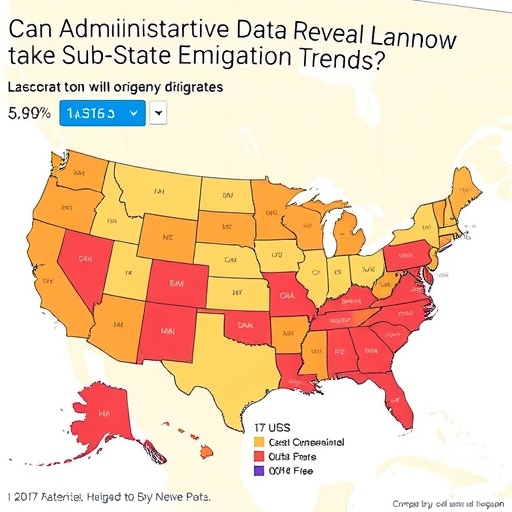In a rapidly globalizing world, understanding migration patterns has become essential for policy formation and demographic study. Migration affects economies, cultures, and social structures, making the need for accurate data crucial. Recent research by Wilson, Wu, Bernard, and colleagues addresses a significant challenge in estimating sub-state emigration rates using an administrative population dataset. Their study focuses on the Person Level Integrated Data Asset (PLIDA) of Australia, a transformative tool that has the potential to reshape how we understand demographic movements at a granular level.
Australia’s PLIDA represents a significant innovation in data collection methodologies. Unlike traditional datasets that may only reflect broad trends without enacting detailed migration flows, PLIDA enables researchers to analyze individual-level data across various Australian regions. By integrating multiple administrative datasets, it provides insights into migration behaviors that were previously obscured. The implications of their findings extend beyond mere academic interest; they play a critical role in shaping policies related to immigration, urban planning, and community service provisions.
Understanding the reliability of the estimates derived from PLIDA is pivotal. Wilson and his team meticulously examined the accuracy of sub-state emigration estimates drawn from this comprehensive dataset. Utilizing robust statistical models and cross-referencing emigration events against other datasets helped them establish a baseline for comparing the integrity of the PLIDA-generated data. By demonstrating the soundness of their methodologies, they set a precedent for future studies that will leverage similar administrative data assets.
One of the key advantages of using PLIDA is its ability to provide disaggregated data. This disaggregation allows researchers to investigate the characteristics of migrants—such as age, gender, and socio-economic status—in depth. Such an analysis could reveal otherwise hidden trends, such as which demographic groups are more inclined to emigrate from specific regions. This granularity not only enhances academic understanding but also equips policymakers with the targeted information they need to address migrant needs more effectively.
Additionally, the multi-layered approach to data integration utilized in this research underscores the potential for developing predictive models for future migration trends. By analyzing historical emigration patterns alongside various social and economic indicators, researchers can create simulations that forecast future movements. This ability to anticipate migration flows offers immense value to governments and organizations as they prepare for demographic shifts, economic needs, and resource allocation.
Through their findings, Wilson et al. highlight a burgeoning avenue for further research. Their methodology opens the door for replication in other countries looking to harness administrative data for understanding population dynamics. In an era where accurate migration data is increasingly critical, their research could inspire similar studies worldwide, potentially leading to a more comprehensive global picture of migration.
Moreover, the implications of their work resonate deeply with ongoing discussions about planning and infrastructure. As urban areas continue to evolve in response to migration, understanding the localized movements of populations becomes imperative. For city planners and local governments, accurate sub-state emigration estimates will inform housing policies, transportation infrastructure, and community services, ensuring that resources are allocated efficiently and effectively.
As public discourse around migration becomes more polarized, the necessity for reliable data-driven insights cannot be understated. The empirical evidence provided by Wilson and his colleagues stands in stark contrast to anecdotal narratives often prevalent in public discussions. By grounding their findings in robust quantitative analysis, the researchers contribute to elevating the quality of public debate around emigration.
Another significant aspect of Wilson et al.’s work is its impact on enhancing civic engagement. When citizens are informed by credible data on emigration trends, they are better equipped to participate in discussions about immigration policies. This heightened awareness could foster a greater understanding of the contributions migrants make to society, thereby reducing stigma and promoting inclusivity.
Furthermore, the researchers’ examination of the PLIDA dataset also reveals the dynamic nature of emigration itself. It is not a static phenomenon but one that is influenced by myriad factors ranging from economic opportunities to social networks. This complexity necessitates continuous monitoring and analysis to ensure that policies evolve in tandem with these changes.
The case study of PLIDA serves as a powerful reminder of the potential that resides within administrative datasets. These resources, often underutilized, can yield profound insights into societal dynamics when approached with innovative methodologies. Wilson and his team’s rigorous analysis paves the way for further exploration into how such data can be harnessed to inform policy and address the needs of diverse communities.
As we look ahead, the research conducted by Wilson, Wu, Bernard, and their colleagues underscores the need for continued investment in data infrastructure that supports migration studies. This commitment will empower researchers to uncover the nuanced realities of emigration, enabling societies to navigate the challenges and opportunities presented by migration in more informed and equitable ways.
In conclusion, the study by Wilson et al. is a call to action for both researchers and policymakers alike. By proving that reliable estimates of sub-state emigration can be derived from administrative datasets like PLIDA, they have opened new pathways for understanding migration at a granular level. This work is not only invaluable to academia but also has vital implications for society at large, paving the way for more informed decision-making in the complex landscape of migration.
Subject of Research: Sub-state emigration estimates from administrative datasets
Article Title: Can reliable sub-state emigration estimates be obtained from an administrative population dataset? The case of the Person Level Integrated Data Asset (PLIDA) of Australia.
Article References:
Wilson, T., Wu, G., Bernard, A. et al. Can reliable sub-state emigration estimates be obtained from an administrative population dataset? The case of the Person Level Integrated Data Asset (PLIDA) of Australia.
J Pop Research 42, 6 (2025). https://doi.org/10.1007/s12546-024-09355-w
Image Credits: AI Generated
DOI:
Keywords: Administrative datasets, migration patterns, sub-state emigration estimates, PLIDA, demographic movements, migration policy.




